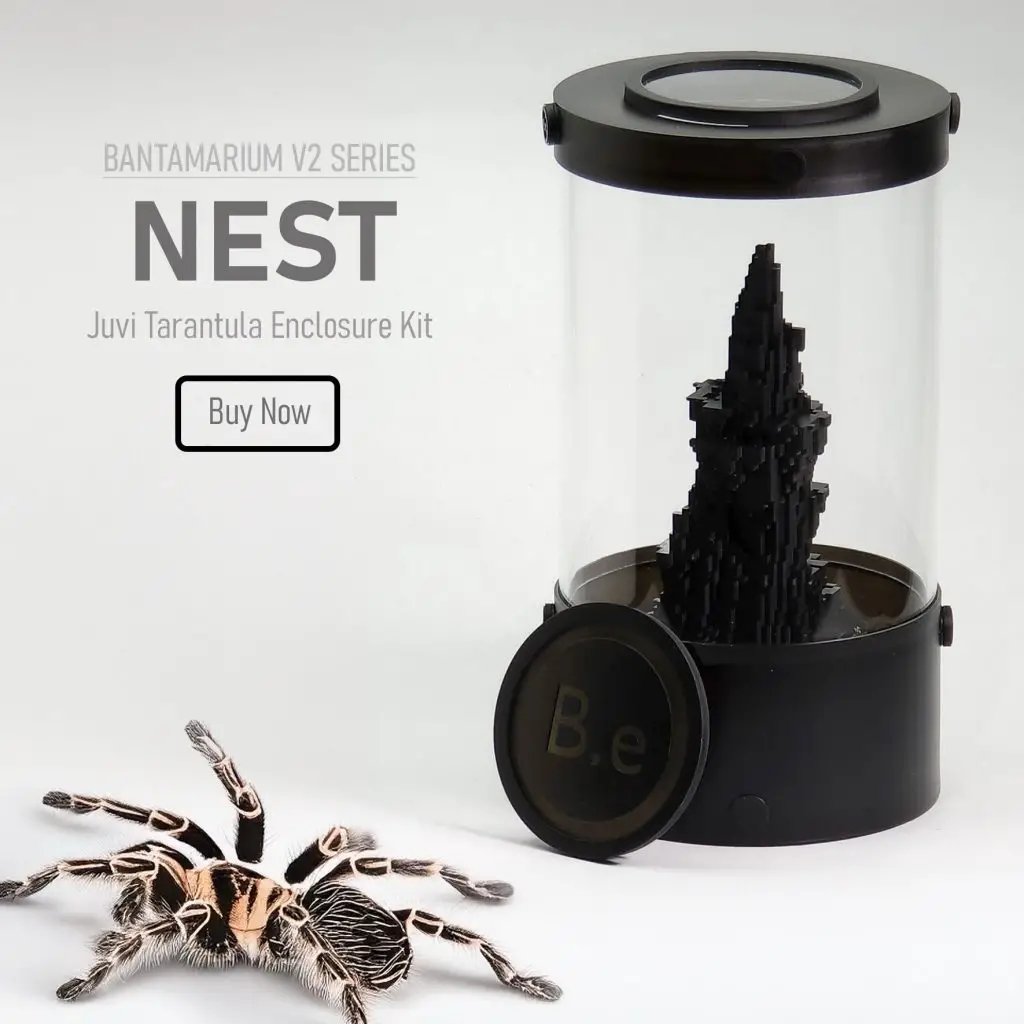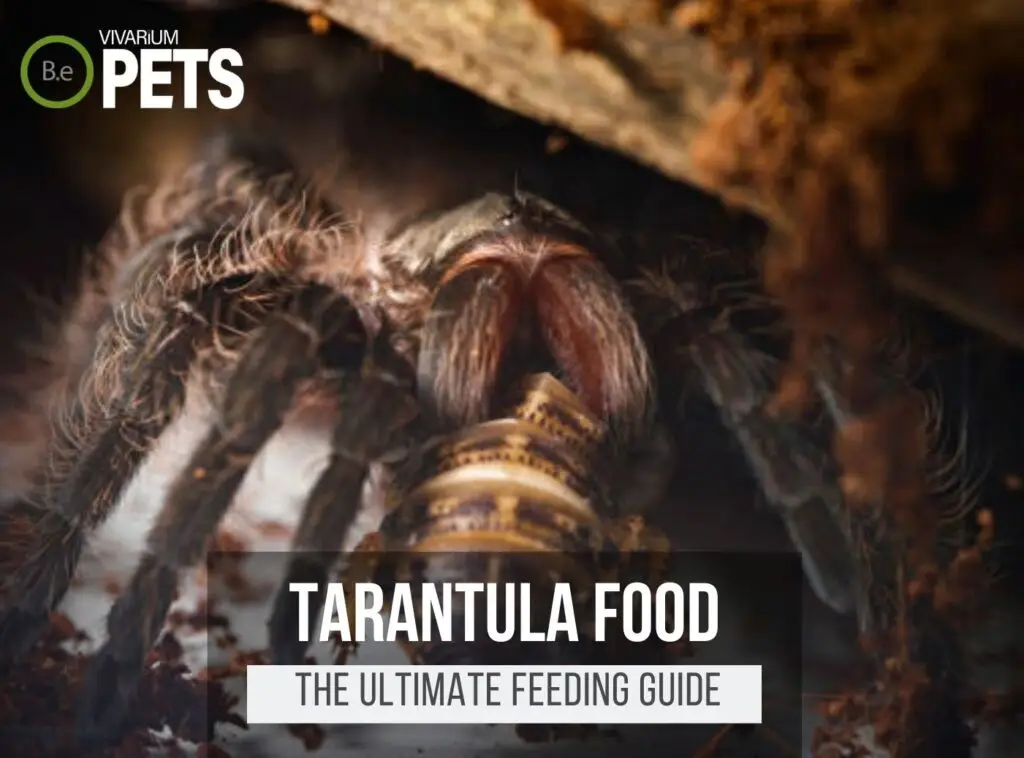The Fringed Ornamental Tarantula is one of the larger species of pet tarantula we’ve covered so far.
These incredible arachnids may look intimidating, but with proper care and knowledge, they can make an exciting and rewarding pet.
In this care guide, we’ll provide you with all the information you need to give Poecilotheria ornata the environment, nutrition, and attention it needs.
Table Of Contents:
ToggleWhat Are Fringed Ornamental Tarantulas?
Fringed Ornamental Tarantulas, also known by their scientific name Poecilotheria ornata, are terrestrial spiders belonging to the Theraphosidae family.
They are native to India and Sri Lanka. The species’ common name is derived from the unique fringes on their legs which are made up of brilliant blue and black banding.
Fringed Ornamental Tarantulas may reach up to almost a foot long, making them one of the larger tarantulas.
Create the perfect home for your arachnid with our Customizable Spider Enclosure Kits, designed to meet all their habitat needs.
What Do Fringed Ornamental Tarantulas Look Like?
Fringed Ornamental Tarantula has a stout, curved abdomen with long, strong legs covered in spines.
As their name implies, these tarantulas are adorned with fringed hairs on their legs and abdomens.
They can range in color from bright shades to muted tones, typically featuring a brown or pink hue and sometimes with purple streaks.
Poecilotheria ornata can grow up to 10 inches in length, reaching maturity in two to three years.
They have fangs that are fused and are equipped with sensory organs at the tips of their feelers, or palps, which help them to find prey in their native rainforest environments.
These tarantulas can be identified by the distinct horns adorning their carapaces and the wide, web-like patterns on their abdomens.
Benefits Of Using Fringed Ornamental Tarantulas
Fringed Ornamental Tarantulas make a great addition to many types of vivariums.
Not only do they add aesthetic appeal, but they also help to maintain insect populations, as well as act as a natural predator.
To encourage healthy growth, they require a specific habitat that is temperature-controlled, with appropriate levels of humidity and lighting.
Plus, they are easy to feed and handle, making them ideal for both beginner and experienced arachnid keepers.
With the right care, Poecilotheria ornata can live a long and healthy life as a part of your enclosure.

Fringed Ornamental Tarantula Facts
Fringed Ornamental Tarantulas are insectivorous arachnids, found mostly in Sri Lanka.
They have a unique pattern with bright orange to yellow hues, and males can reach leg spans up to several inches.
Poecilotheria ornata are known to be docile, though can be skittish with handling.
These arachnids have a long lifespan of many years and can be successfully bred in captivity.
Habitat
Specifically, Poecilotheria ornata come from a wet climate in the Eastern Ghats mountain range in South India.
In their natural habitat, they are often found in old, hollow trees, rock crevices, and other dark nooks.
The surface of their natural habitats is warm and humid with a temperature range of 65°F – 85°F and relative humidity of 80 – 90%.
These tarantulas prefer to spend their days hiding in small caves or crevices near the trunks of trees and during the night, they scavenge for food.
Replicate their natural habitat perfectly with our bioactive species-specific soil mixes, designed to provide the ideal moisture and organic content for your spiders.
Diet
The diet of Fringed Ornamental Tarantulas largely consists of other insects, such as crickets, cockroaches, and flies.
When in the wild, these creatures can typically find a plentiful source of food.
They are active hunters and will wander about in the nighttime, looking for prey to feed on.
Some have even been observed taking on small lizards or frogs occasionally.
While molting, the tarantula may consume its old exoskeleton, and you should take extra care to ensure that there is a source of calcium in the diet to supplement the lack of calcium in the exoskeleton.
Temperament
Poecilotheria ornata has a generally timid and reclusive temperament.
These tarantulas prefer to avoid contact with humans and other animals, so when handling them, extreme caution is advised.
It’s always best to use forceps when handling these tarantulas and to be extremely gentle and respectful in all interactions.
When threatened, the tarantula can defend itself by using its urticating bristles.
It’s best to avoid any situation that might provoke the tarantula to feel threatened, such as a sudden and forceful movement.
Tarantulas may also kick hairs from their abdomen in self-defense, so it’s wise to wear protective clothing when working with them.
In general, Fringed Ornamental Tarantulas prefer to be kept solitary and without interference.
Lifespan
The lifespan of Poecilotheria ornata can range from 3 to 12 years, depending on its environment, sex, and care.
Males typically live shorter lifespans averaging around 3 years, while females live 4 times longer with an average of 12 years.
In captivity, they typically have a longer life expectancy due to the control and stability within their living space.
They have a distinct life cycle like most other tarantula species; they hatch from eggs as spiderlings, molt several times as they grow (typically 6-7 times), and reach maturity at around a year or two old.
Breeding
During the breeding season, Fringed Ornamental Tarantulas reach sexual maturity.
To increase your chances of successful mating, it is advisable to keep both sexes in separate enclosures until they are ready to mate.
After introducing the male and female tarantulas and allowing them to get comfortable in each other’s company, the female will begin to release pheromones to indicate her willingness to mate.
The male will serve as the aggressor and will attempt to woo the female by dancing and showing off his specialized body markings.
Once the female has been wooed, he will then initiate physical contact before eventually mounting the female.
During this stage, the male will begin a process known as vibratory courtship.
This is when he produces mating vibrations using his stridulating organ.
After the courtship is completed, the female will create a sperm web, where she will entrap the sperm mass.
After mating, both sexes can remain together for weeks.
The female will carry the sperm mass with her until she is ready to lay her eggs.
Once she has laid her eggs, she will create an egg sac to protect and insulate them.
Females of some species will continue to protect their egg sacs even after they have hatched until the young emerge.
Where To Find Fringed Ornamental Tarantulas
Poecilotheria ornata can be found in Southwestern India. In these locations, they inhabit large trees and shrubs.
If you’re looking for a Fringed Ornamental Tarantula as a pet, they can also be found for sale in some pet stores and online.
You can also purchase them directly from breeders.
When purchasing venomous spiders, we recommend buying them from reputable breeders as wild-trapped specimens may have already been exposed to countless potential dangers before rescue.
Fringed Ornamental Tarantula Care
To properly care for Poecilotheria ornata, create a suitable habitat by providing proper temperature, humidity, and terrarium lighting along with appropriate furnishings.
Feed appropriate prey items according to size and meal frequency.
Handle carefully, and when breeding, create a separate breeding tank, sex the tarantulas properly, and differentiate between male and female spiderlings.
Tank Requirements
A vital part of caring for a Fringed Ornamental Tarantula is providing them with the right tank setup.
A 20-gallon terrarium is ideal for one adult tarantula, constructed preferably of plastic, glass, or wood.
The ideal pH should be 8.0-8.5, with 4-8 dGH of water hardness, temperature between 75-85°F (24-29°C), and humidity around 75%.
The floor should be lined with 2-4 inches of substrate such as coconut fiber.
To provide the right lighting, cave-dwelling plant bulbs, fluorescent bulbs, or black-and-red spotlights are all suitable.
What Do Fringed Ornamental Tarantulas Eat?
When it comes to feeding your Poecilotheria ornata, it’s good practice to provide high-quality offerings that are suitable for the species.
Some of the best foods for this tarantula include crickets, roaches, silkworms, mealworms, and flies.
You can also provide occasional treats like earthworms and pinky mice.
It’s important to choose food items that are slightly smaller than the size of the spider’s body.
When feeding your Fringed Ornamental Tarantula, you should offer food every 5-6 days.
Place the food items into the terrarium during the evening hours. This will give the tarantula plenty of time to hunt and consume its prey.
Make sure to remove any leftover food items from the enclosure after 24 hours. This will help to keep the enclosure clean and uncontaminated.
If you’re looking for a more detailed approach to feeding these arachnids, be sure to check out my ultimate DIY tarantula food guide. I give a more in-depth explanation of the best foods and my favorite recipe.
Best Tankmates For Fringed Ornamental Tarantulas
When keeping Fringed Ornamental Tarantulas, it’s essential to choose their tankmates carefully.
Although these tarantulas will not display aggression toward other arachnids, it’s good to remember that they are solitary creatures.
Therefore, it is best to avoid housing Poecilotheria ornata with other tarantulas or arachnids.
That said, there are several beneficial companions for these spiders that you can consider.
These include pet isopods, springtails, snails, and other invertebrates that are passive and will not threaten the tarantula.
These animals can help create an interesting and diverse habitat that will benefit your pet in many ways.
For instance, many of these animals are known to help keep the environment clean by eating debris and waste.
Choosing the right tankmates can create a harmonious home for your pet and ensure it gets the best care.
Conclusion
Caring for Poecilotheria ornata can be a rewarding experience, but it requires a lot of knowledge and attention to detail.
This care guide should serve as a great starting point to learn more about the basics of tarantula care and breeding.
With patience and dedication, you can ensure the health and longevity of your pet and create a strong bond with your Fringed Ornamental Tarantula.
Create the ideal habitat for your arachnids with our species-specific soil mixes and Spider Enclosure Kits. These products provide everything you need for a thriving spider habitat.
Frequently Asked Questions
No, Poecilotheria Ornata is not poisonous to humans.







